
The Middle Kingdom of Egypt is the period in the history of ancient Egypt following a period of political division known as the First Intermediate Period. The Middle Kingdom lasted from approximately 2050 to 1710 BC, stretching from the reunification of Egypt under the reign of Mentuhotep II in the Eleventh Dynasty to the end of the Twelfth Dynasty. The kings of the Eleventh Dynasty ruled from Thebes and the kings of the Twelfth Dynasty ruled from el-Lisht.

The Twelfth Dynasty of ancient Egypt is often combined with the Eleventh, Thirteenth and Fourteenth Dynasties under the group title Middle Kingdom.

Amenemhat I also Amenemhet I and the hellenized form Ammenemes, was the first ruler of the Twelfth Dynasty, the dynasty considered to be the golden-age of the Middle Kingdom of Egypt. He ruled from 1991 BC to 1962 BC.
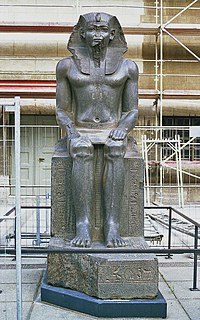
Nubkaure Amenemhat II was the third pharaoh of the 12th Dynasty of Ancient Egypt. Although he ruled for at least 35 years, his reign is rather obscure, as well as his family relationships.

Senusret I also anglicized as Sesostris I and Senwosret I, was the second pharaoh of the Twelfth Dynasty of Egypt. He ruled from 1971 BC to 1926 BC, and was one of the most powerful kings of this Dynasty. He was the son of Amenemhat I. Senusret I was known by his prenomen, Kheperkare, which means "the Ka of Re is created."

Khakheperre Senusret II was the fourth pharaoh of the Twelfth Dynasty of Egypt. He ruled from 1897 BC to 1878 BC. His pyramid was constructed at El-Lahun. Senusret II took a great deal of interest in the Faiyum oasis region and began work on an extensive irrigation system from Bahr Yussef through to Lake Moeris through the construction of a dike at El-Lahun and the addition of a network of drainage canals. The purpose of his project was to increase the amount of cultivable land in that area. The importance of this project is emphasized by Senusret II's decision to move the royal necropolis from Dahshur to El-Lahun where he built his pyramid. This location would remain the political capital for the 12th and 13th Dynasties of Egypt. The king also established the first known workers' quarter in the nearby town of Senusrethotep (Kahun).
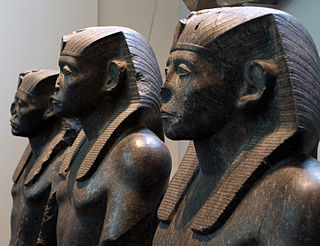
Khakaure Senusret III was a pharaoh of Egypt. He ruled from 1878 BC to 1839 BC during a time of great power and prosperity, and was the fifth king of the Twelfth Dynasty of the Middle Kingdom. He was a great pharaoh of the Twelfth Dynasty and is considered to be, perhaps, the most powerful Egyptian ruler of the dynasty. Consequently, he is regarded as one of the sources for the legend about Sesostris. His military campaigns gave rise to an era of peace and economic prosperity that reduced the power of regional rulers and led to a revival in craftwork, trade, and urban development. Senusret III was among the few Egyptian kings who were deified and honored with a cult during their own lifetime.

Beni Hasan is an Ancient Egyptian cemetery site. It is located approximately 20 kilometers (12 mi) to the south of modern-day Minya in the region known as Middle Egypt, the area between Asyut and Memphis.
Amenemhat or Amenemhet is an Ancient Egyptian name meaning "Amun is in front". Amenemhat was the name of a number of kings, princes and administration officials throughout ancient Egyptian history.
Senusret is the name of several Ancient Egyptians:

Khnumhotep III was an Ancient Egyptian high steward and vizier of the 12th Dynasty.
Khenemetneferhedjet(ẖnm.t nfr-ḥḏ.t) was an ancient Egyptian queenly title during the Middle Kingdom. It was in use from the 12th to the early 18th dynasty. During the 12th dynasty it also occurred as a personal name. Its meaning is “united with the white crown”. The white crown was one part of the double crown of Egypt and is usually interpreted to have represented Upper Egypt, but it is also possible that while the red crown represented the king's earthly incarnation, the white crown represented the eternal, godlike aspect of kingship.

The High Priest of Ptah was sometimes referred to as "The Greatest of the Directors of Craftsmanship" (wr-ḫrp-ḥmwt). This title refers to Ptah as the patron god of the craftsmen.
Articles related to ancient Egypt include:

Djehutihotep was an ancient Egyptian nomarch of the fifteenth nomos of Upper Egypt during the twelfth dynasty, c. 1900 BC.
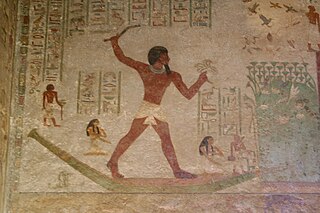
Khnumhotep II was an ancient Egyptian Great Chief of the Oryx nome during the reign of pharaohs Amenemhat II and Senusret II of the 12th Dynasty, Middle Kingdom. He is well known for his tomb at Beni Hasan and its decorations.
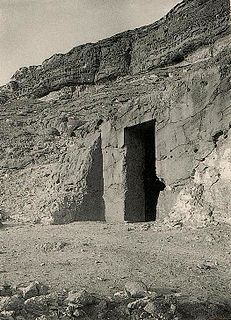
Khnumhotep I was an ancient Egyptian Great Chief of the Oryx nome during the reign of Pharaoh Amenemhat I of the 12th Dynasty, Middle Kingdom.
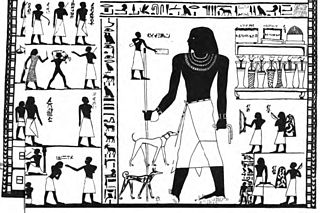
Amenemhat, often reported with his short form Ameny (Jmnjj), was an ancient Egyptian "Overlord of the Oryx nome" and chief priest during the reign of pharaoh Senusret I of the 12th Dynasty.

The Oryx nome was one of the 42 nomoi in ancient Egypt. More precisely, it was the 16th nome of Upper Egypt. It was named after the Scimitar oryx, and was roughly located in the territories surrounding the modern city of Minya in Middle Egypt.

Sarenput II, also called Nubkaurenakht was an ancient Egyptian nomarch during the reign of pharaohs Senusret II and Senusret III of the 12th Dynasty.
This page is based on this
Wikipedia article Text is available under the
CC BY-SA 4.0 license; additional terms may apply.
Images, videos and audio are available under their respective licenses.















